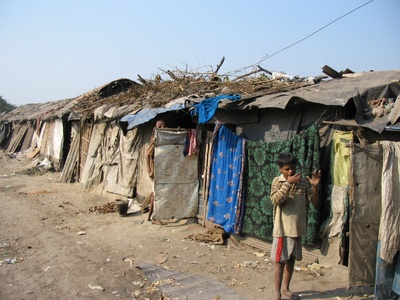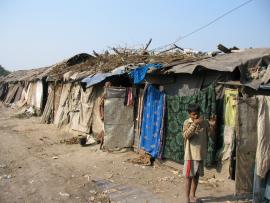Indoor Air Pollution
Description
Indoor Air Pollution (IAP) describes the adverse ambient air conditions inside households, schools, places of work and other indoor spaces. This can be caused by a range of sources, including stoves, smoking and machinery. Most IAP occurs in the developing world.
Context
The most significant cause of indoor air pollution in the developing world is the burning of coal or unprocessed biomass fuels for cooking, heating and light. More than 50% of the world’s population gets their energy for cooking in this way. Almost all of these people live in poor countries.
Biomass fuels include wood, animal dung and crop residues. While high income nations have long since converted to petroleum products or electricity for cooking, most people in the developing world still rely heavily on this most basic form of energy production. In China,
India and Sub Saharan Africa, it is estimated that more than 80% of urban households get their energy for cooking in this manner1, and more than 90% in rural areas.2
Biomass fuels are typically burned in rudimentary stoves. Importantly, few of these fully combust the fuel, therefore resulting in inefficient use of precious fuel and unnecessarily large air emissions.3 The high amount of emitted particulate coupled with usually poor ventilation produces indoor concentrations of toxic fumes which are a very real health risk to families. Those most affected are women, who do most of the cooking, as well as infants, who are often times strapped to the backs of their mothers.
Exposure Pathways
Indoor Air Pollution mostly affects health through inhalation, but can also affect the eyes through contact with smoke. IAP happens largely in the household where cooking, sleeping, eating and other activities take place. Women and children are therefore most at risk. The burning of biomass fuels adds to particulate. Particles with diameters of less than 10 microns (PM10) and particularly those less than 2.5 microns in diameter (PM2.5) are small enough to penetrate deeply into the lungs.4
The US EPA recommends exposure standards based on a 24 hour average. In this time frame, it is recommended that average concentrations of PM10 should not exceed 150 ug/m3. In homes that cook with biomass fuels, concentrations are typically in the range of 300 to 3000 ug/m3, or up to 20 times higher than recommended levels. At times of cooking this number can reach as high 30,000 ug/m3 or 200 times the recommended level.
Health Risks
Indoor Air Pollution contributes to nearly 3 million deaths annually, and constitutes 4% of the global burden of disease.5 The largest health effects include:
•Acute Respiratory Infections (ARI). ARI accounts for 1/8 of the total disease burden in India, making it the largest single disease category6
•Chronic Obstructive Pulmonary Disease (COPD) COPD includes bronchitis, and accounts for 16% of female deaths in China.7
•Lung Cancer. Some two-thirds of women in China, India, and Mexico are non-smokers8
•Cataracts. Studies have found that women that use biomass fuels for cooking are as much as 2.4 times more likely to suffer from cataracts caused blindness.9
•Tuberculosis. Studies have found an adjusted risk of 2.7 for women that cook with wood in India.10
•Adverse Pregnancy Outcomes. In rural Guatemala, babies born to women that cook with wood fuels were 63 g lighter than those born to women using gas and electric.11
Some sites that have been notes as examples of the problem
Because Indoor Air Pollution is so widespread, Blacksmith receives few nominations for specific sites. Biomass fuel use strongly correlates with per capita income, as this is what inhibit or encourages the transition to cleaner fuels and stoves. Therefore the area most worth highlighting here is Sub Saharan Africa, where per capita incomes remain lowest.
What is Being Done
Hundreds of campaigns have been implemented around the world to end the threat posed by IAP. Most of these have focused on the introduction of more fuel efficient stoves. However, these efforts need to be complemented by more comprehensive approaches to include improved ventilation, lifestyle changes, and host of other interventions ultimately resulting in a transition to cleaner burning fuels.
Footnotes
1 Smith, K.R. “Indoor air pollution in developing countries: recommendations for research.” Indoor Air 2002: 12: 198-207.
2 Bruce, Nigel; Neufeld, Lynnette; Boy, Erick and West, Chris. “Indoor biofuel air pollution and respiratory health: the role of confounding factors among women in highland Guatemala” International Journal of Epidemiology. 1998: 27: 454-458
3 ibid
4 ibid
5 ibid
6 Smith, K.R. “Indoor air pollution in developing countries: recommendations for research.” Indoor Air 2002: 12: 198-207.
7 ibid
8 Bruce, Nigel; Neufeld, Lynnette; Boy, Erick and West, Chris. “Indoor biofuel air pollution and respiratory health: the role of confounding factors among women in highland Guatemala” International Journal of Epidemiology. 1998: 27: 454-458
9 Smith, Kirk R. “National burden of disease in India from indoor air pollution” PNAS. November 2000. Vol 97. No. 24: 13286-13293.
10 ibid
11 Bruce, Nigel; Neufeld, Lynnette; Boy, Erick and West, Chris. “ Indoor biofuel air pollution and respiratory health: the role of confounding factors among women in highland Guatemala” International Journal of Epidemiology. 1998: 27: 454-458
Additional Resources
Indoor Air Pollution (word doc)
Additional Photos
 |
Indoor Air Pollution is a widespread problem in poor communite like this one worldwide. Kolkata, India. Photo by Blacksmith Institute. |
|
Preparing meals in poorly ventilated spaces. Latin America. Photo by Blacksmith Institute. |




